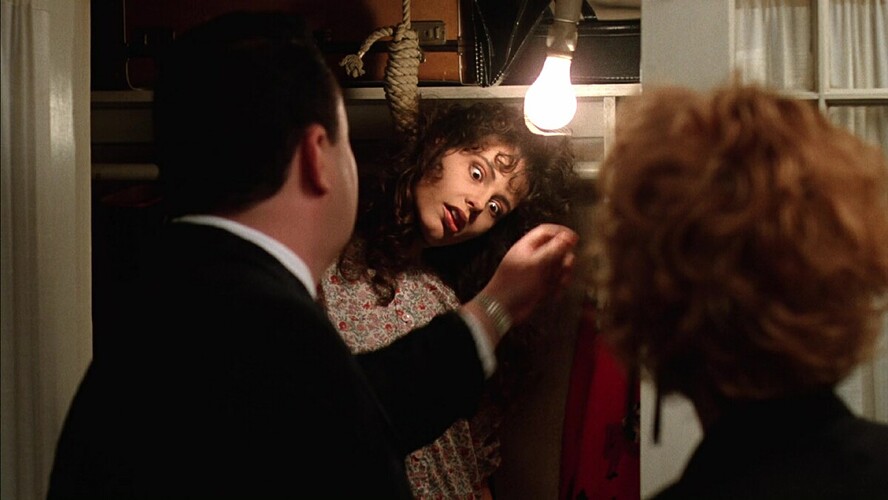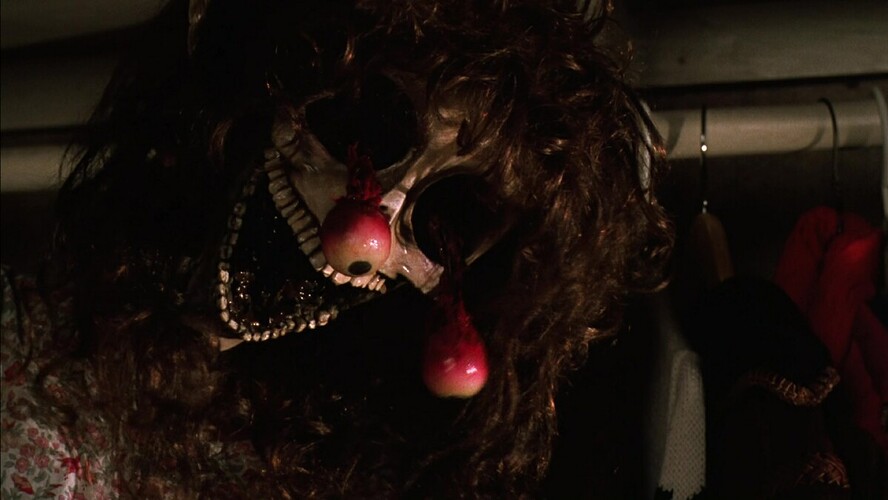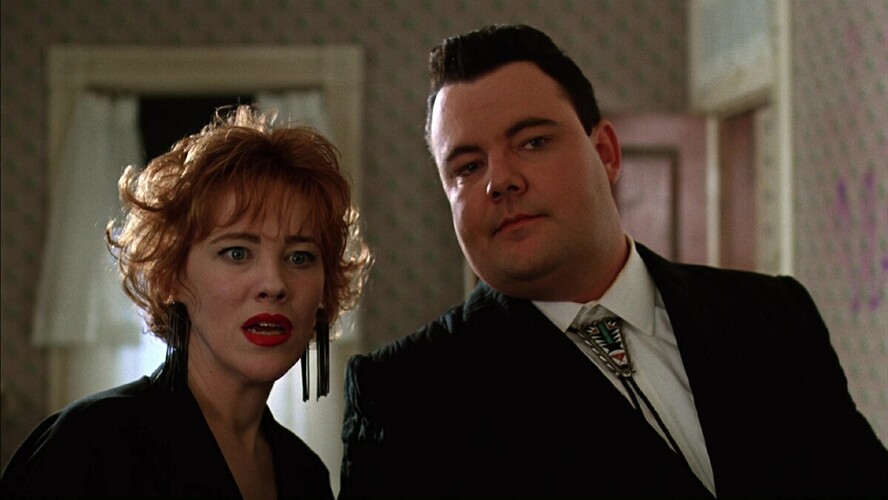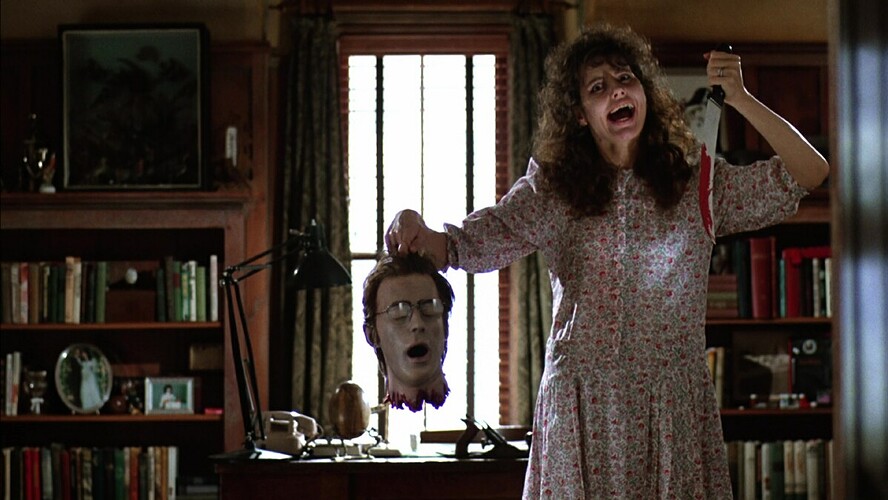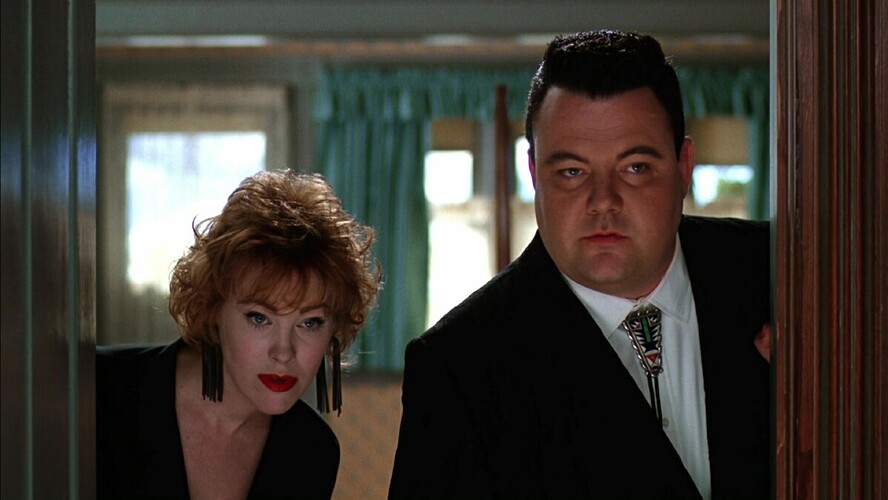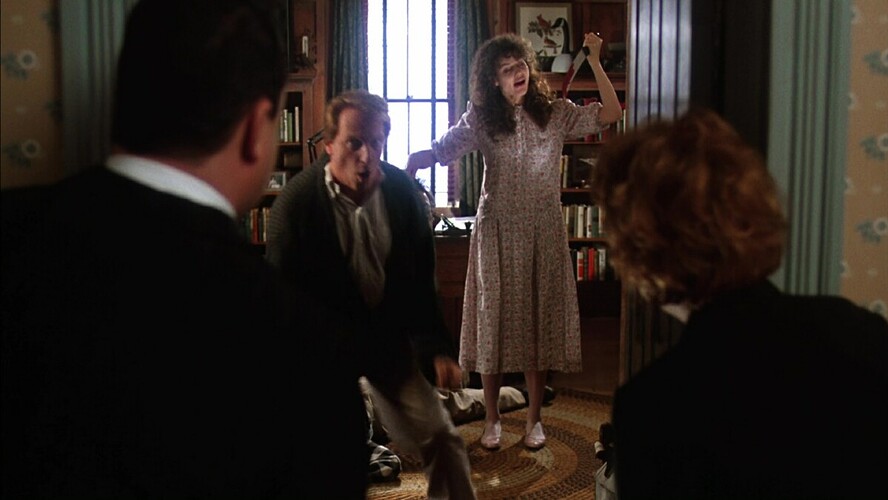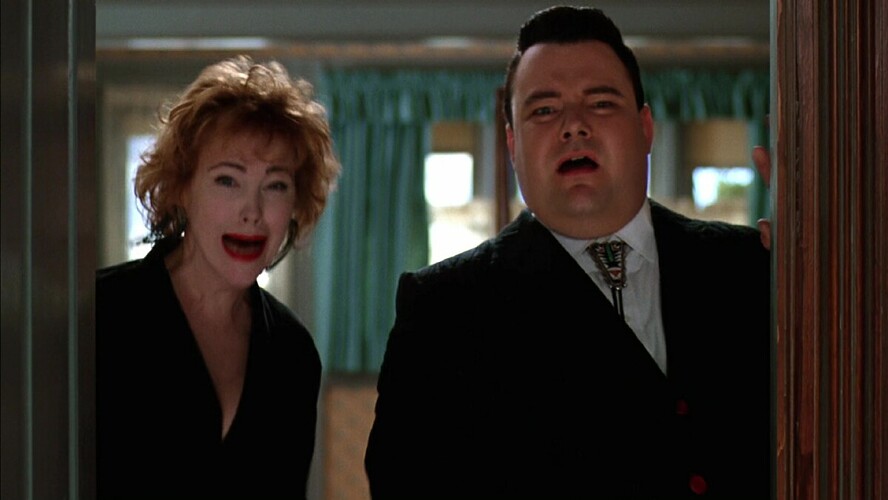Jump scares work, that’s a given. I think the argument is more around the quality of them (whether they are relevant to the plot or just a jumping cat, as well as how they are accomplished re: done well in the brain or done poorly in the ears and the eyes) and how cheaply they are used. A shitty movie with a jump scare makes for a shitty jump scare, at the end of the day.
I’m reading a novel by one of the writers of Beetlejuice and also catching up on my early Michael Keaton movies, so last night I rewatched Beetlejuice. And found a fun commentary on jump scares!
Geena Davis and Alec Baldwin are ghosts, and they want to scare Catherine O’Hara’s family out of the house they’re haunting. So they try to stage horror scares! In the first attempt, Geena Davis reveals herself as a hanged corpse in a closet. Catherine O’Hara, playing Catherine O’Hara, and Glenn Shadix, playing a flamboyant psychic/interior decorator, open the closet door, switch on a light bulb, and there’s Geena Davis swinging adorably from a noose.
They don’t react. She’s going to have to crank up the scares. So she reaches up, rips off off her own face, and screams as her eyeballs pop out:
It’s supposed to be a jump scare, but it doesn’t work because that’s the point! Without something lunging into the frame, it’s not a jump scare to the audience even though it’s abrupt and presumably grotesque in that cutely grotesque early Tim Burton way. But because our ghosts don’t have enough haunting juice, it’s not a jump scare to Catherine O’Hara or Glenn Shadix:
Our ghosts are not scary! That’s the reveal here. It’s a cute gag, but it’s not over. Geena Davis is going to give it another try. O’Hara and Shadix come to a study. They open the door, look through the doorway, and there’s Geena Davis adorably holding Alec Baldwin’s head in one hand and a bloody knife in the other!
O’Hara and Shadix don’t react.
But then Jeffrey Jones leaps into frame from behind the wall on the left and screams…
…which scares O’Hara and Shadix because they were looking into the room through a doorway and didn’t see him:
It also presumably scares the audience because this time someone lunged into frame from out of sight, but it was nothing supernatural. The joke here is that our ghosts are so weak, they can’t manage a scare. But jump scares are so cheap that even (only?) a pesky human can do it!
So, basically, Tim Burton uses jump scares in Beetlejuice to show that our ghost heroes are so unscary that they need to call Michael Keaton.
-Tom
I apologize if I’m coming across and strident or inflexible. I have strong opinions about movies and I like sharing them, and sometimes I’ll do that in ways that are intended to get a reaction. Saying “there are no good jump scares” when I obviously don’t believe that is a tactic, and not an actual opinion.
I have made a career out of implying that things are “good” or “bad” in provocative ways, hopefully to start a discussion, or to be entertaining, or at least informative. But I’ve never claimed any objective insight into whether something is “good” or “bad”, and I’ve furthermore tried to remind people of that fact when discussing my opinion. If that’s not coming across, I’ll work on that.
However, I do need to point out that you’re throwing down an unreasonable standard with this:
You seem to be saying this discussion is only valuable if my mind changes. I don’t think you believe that for one minute. But if you want to change my mind somehow, post more examples of what you consider good jump scares. This thread is full of 'em, and at least one of them was posted by you!
-Tom
I love that Beetlejuice sequence. Too funny.
I think it’s okay for jump scares to violate certain “rules of logic or audience omniscience” if you can interpret the sequence as a reflection of the character’s psychological state.
That bus startle from Cat People is a good example… it’s not a stretch to think she didn’t hear the bus coming if she’s distracted and afraid. You can’t always expect characters in horror movies to be thinking straight! But it can be frustrating when folks take cheap shots criticizing scenes when they’re kind of missing the point.
It’s been a fun discussion. My original comment was about YOUNG PEOPLE TODAY. There are certain rites of passage that I have to be patient with and this hatred of jump scares is one of them.
Well I think that’s a tactic used by lesser writers. Ha! I’m joking. But I couldn’t resist.
But I do appreciate your clarifying what you’re doing. And just so I’m clear, my main problem here is that I couldn’t figure out where your head is at. Posting a thread title with a definitive statement that there are no jump scares seemed like a pretty obvious attempt to stir up discussion, drag out the defenders. Which I get, and I’m totally onboard with. Then some folks came up with some good examples, yourself included, and we had a stew going baby! But then you would pipe up with comments like jump scares being “cheap” or tools that only a crappy director would use. Which confused me; that seemed to me to indicate that you really did feel that jump scares were terrible, full stop, or maybe I just totally misread the situation? But now I guess that was just you continuing to fan the flames of discussion with somewhat inflammatory statements?
And just so I’m clear here, no - I do not believe that it’s necessary for you to change your mind for this discussion to have value. For the record, I don’t really care whether you like or dislike jump scares, in fact I’ve probably given more thought to jump scares over the course of this thread than I have over the rest of my life, so hat’s off to you for that. I guess what I’m trying to do is facilitate a flow of ideas, so that we both get where the other is coming from. Not so much to jujitsu the other into giving up their position. I didn’t really get where you were coming from, and was trying to clarify. I think I have a better handle on that, so I’ll derail no further.
I apologize if I missed it further back in this thread, but was the chum scene in Jaws ruled in your book as not a jump scare, or an exception to the rule that jump scares are bad?
I don’t actually have a book of what is and isn’t a jump scare, but if I did, this would be the first entry because it’s probably the single most formative moviegoing moment in my life.
But what would be the rationale to claim it’s not a jump scare? If it’s because there’s no loud sound effect, keep in mind there is when you see it in a theater full of people who scream at that moment. But it’s still a cheap trick because it relies on you and Brody being unable to see beyond a certain depth in the water. It’s a dick move from both the shark and the director!
-Tom
Ah, gotcha. Thanks for explaining. I guess for me, I wouldn’t consider that cheap since it’s plausible that Brody wouldn’t have seen the shark beforehand, so the scare isn’t entirely dependent on cheated framing and sound effects.
It’s not just plausible: it’s right there on the screen. We the viewers are looking straight at the water the whole time, and there’s no shark until it pops up.* To assert the shark has be visible a whole lot earlier means either you believe that New England seawater is always crystal clear to a great depth (which trust me it is not) or that the standards of “non-cheap” filmmaking demand crystal clear waters regardless, so that viewers can be “fairly” warned of any possible scare well in advance.
More to the point, as the shot also makes clear and Tom already mentioned, Brody doesn’t see the shark appear because his head is turned in the other direction while he complains. In other words, he’s distracted.
Which is generally what the “telegraphed” jump scares are about. The character in the scene is distracted by something, whether it’s a literal thing, or just brooding about an idea. While both the character and the audience are caught up thinking about the first thing, they are suddenly surprised by a second. That’s what the bus scare in Cat People about: the main character is so caught up thinking about who might be following them that they don’t fully register the implication of the bus in front of them (namely that it’s going to open its very, very loud doors - and those old school pneumatic bus doors could be very startling when they opened, even if you anticipated them opening.) Cat People absolutely does cheat by limiting our viewpoint, yes, but the idea is that our limited viewpoint is supposed to be a cinematic representation of the character’s distraction.**
But the Jaws scene doesn’t cheat. We the viewers don’t just see what the character sees: we see more than that. So I can’t see how it’s “cheap.” It’s just a good jump scare.
*And remember, this is 1975, so there’s no CGI trickery either. I guess the filmmakers may have dyed the water to obscure Bruce for this shot, but really all that would be doing is simulating a day/area where the water was murkier than average.
**Of course, all movies “cheat” all the time by choosing points of view, framing shots, picking when scenes begin and end, and generally forcing what the director wants us to see on the viewers.
The cheapest part is the mild musical cue helping to startle you, but it’s sooooo mild. I feel this one loses its power if you don’t see it in a theater full of unsuspecting people. But honestly, as a jump scare, this one is really mild because I don’t think jump scares had been as firmly “codified” as they are now, for lack of a better word. The Ben Gardner jump scare is the really cheap one in Jaws.
But also, the chum jump scare is actually pretty integral with the whole concept in Jaws. To quote myself from a write-up me and @triggercut did for the front page:
Bolding mine. I mean, the whole thing is mine, but I just now added the bolding. Do I resent the chum jump scare? Yes. Is it cheap? I think so. Could Spielberg have done “better”? Who knows. Certainly not me.
Does it fit with the rest of Jaws? Absolutely.
Well, well, well, it looks like someone brought a gun to a gunfight. :) Well put, @humanton!
-Tom
We still haven’t addressed the Count Chocula in the room.

Exactly! Imagine putting down your book as you were drifting off into sleep and that little creep is peeking around the door at you, with big googly eyes and fangs. Then of course he slips out of view and you’re left to wonder . . .
The word ‘cheap’ here is quite important I think. For example, the original Evil Dead has multiple scares where something leaps into the frame; turns around quickly to reveal a demonic face; or simply smashes through a wall when the hero is resting up against it thinking they’re safe. I’d argue though, that all of these actually work within the film itself and aren’t ‘cheap’ - they’re not totally divorced from the events. They work to keep the high-octane thrill ride of the movie going and are more akin to Tom’s example of the haunted houses where actors leap out at you - they’re part of the experience. The scissors in Exorcist 3 also seem to fit the film, as does the chum scene in Jaws.
It’s when (as Soren said) we get into the territory of ‘cattle-prod cinema’ and it becomes fairly clear that this is the only way the director actually knows to get a scare that for my money they become ‘cheap’ and irritating. I don’t recall Annabelle being all that scary in totality, certainly not like Paranormal Activity, which also has more than its fair share of jumps. Scenes weren’t given much time to breathe or much set up and it felt a lot like the director was just trying to get to the jump as quickly as possible.
I guess scares, like tears or smiles, have to be earned. If it’s just smashing the volume knob up to eleven and popping something into an extreme close-up without really building a connection then it’s cheap and, for my money, don’t add much.
I’d go further and say a ‘good’ jump scare should be a pay-off and relief of tension that’s been building up over more than about a minute and coming hard off the heels of exactly the same technique in a different room two scenes ago.
Going back to Tom’s dissection of the chum scene, I would argue that it’s not that cheap. As I mentioned upthread, it’s also really important for the film and character. This is the first time Brody has really seen the shark (‘You’re going to need a bigger boat’) and emphasizes that the shark is hunting them. It establishes the shark as an antagonist more like a slasher than an animal.
Yeah, I think the word “cheap” is doing a lot of work here, and I keep going back to to the phrase “the rules of audience omniscience” - and I just want to know, how laid down these rules, and what are they? Did anyone tell that hack Kurosawa? He could’ve just obeyed the rules and turned Rashomon into a short.
There are any number of horror films shot from the perspective of a character’s deteriorating mental state, but is @tomchick arguing that that is hacky, cheap bullshit that violates audience omniscience? I submit to you, that no, he does not, because is no such thing. It’s a cheap rhetorical invention designed to dismiss a cinematic device that makes him feel bad.
Someone in the thread already beat you to that particular slight:
If your goal was to make me regret starting the thread, you’ve both done a fine job. :(
-Tom
Aw come on man, I said I was joking!
No, I know, but at some point the discussion turned contentious and it’s apparently not just you. I have no idea whose fault that was and I’m certainly willing to accept some of the blame, but I regret starting the thread.
-Tom
I love this kind of thematic framing, particularly in horror films. For some reason I keep returning in my mind to The Lodge, which was a bit of a trifle, but accomplished what it did by deliberately framing some things out of shot–in darkness, on the other side of a doorway or through a window. There were many shots in the film where a person was speaking off frame to someone in-frame so we can watch a reaction. It’s an effective, but meta technique. We are used to film conventions and so when we’re not shown what we expect to see, especially when it’s just over there and the characters in-frame can see it, it feels almost claustrophobic.
Well, please don’t take my tone as combative as much as much as smug (because I’m so sure I’m correct), but when you make a declarative statement, you sort of invite big swings. But the question remains, why are you ok with something like St Maud or whatever, while dismissing the chumming the waters scene as cheap? They’re both tied to the character POV, but one is actually clearly rooted in objective reality, so is actually more fair.
